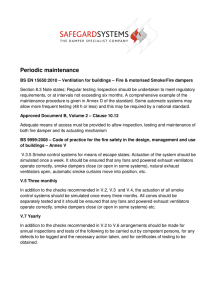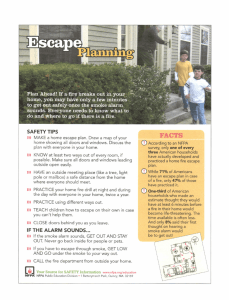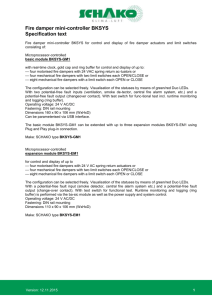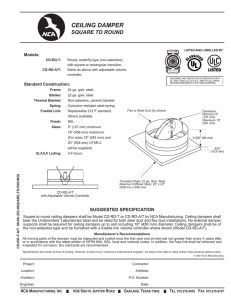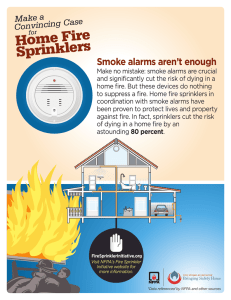MAINTENANCE AND TESTING OF FIRE/SMOKE DAMPERS
advertisement
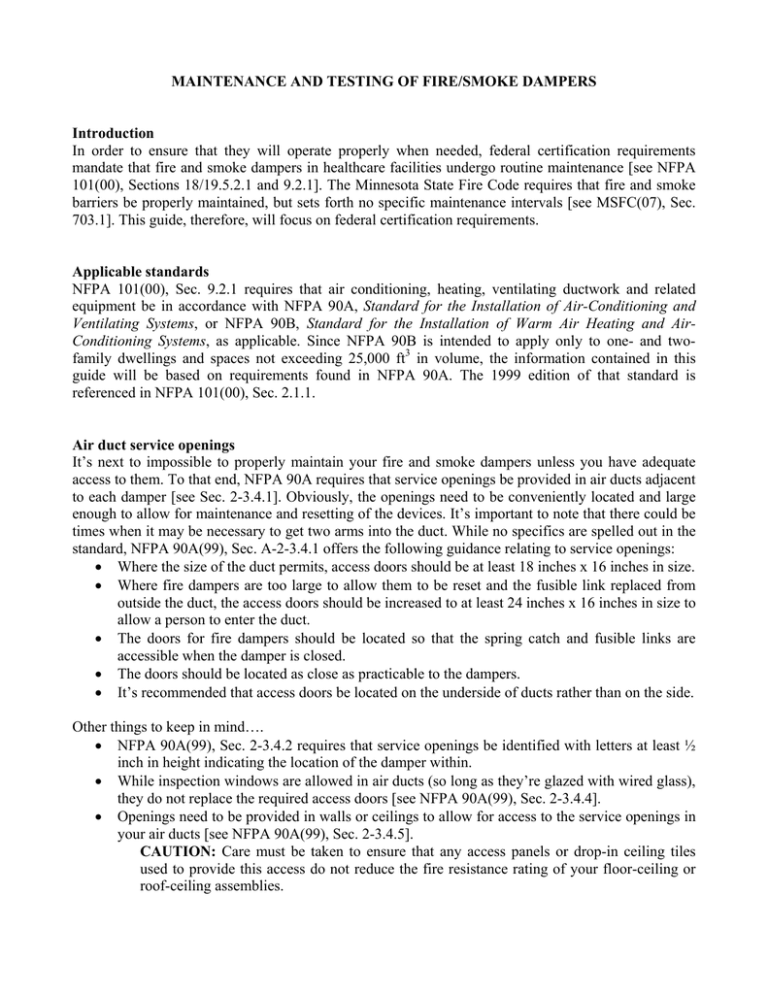
MAINTENANCE AND TESTING OF FIRE/SMOKE DAMPERS Introduction In order to ensure that they will operate properly when needed, federal certification requirements mandate that fire and smoke dampers in healthcare facilities undergo routine maintenance [see NFPA 101(00), Sections 18/19.5.2.1 and 9.2.1]. The Minnesota State Fire Code requires that fire and smoke barriers be properly maintained, but sets forth no specific maintenance intervals [see MSFC(07), Sec. 703.1]. This guide, therefore, will focus on federal certification requirements. Applicable standards NFPA 101(00), Sec. 9.2.1 requires that air conditioning, heating, ventilating ductwork and related equipment be in accordance with NFPA 90A, Standard for the Installation of Air-Conditioning and Ventilating Systems, or NFPA 90B, Standard for the Installation of Warm Air Heating and AirConditioning Systems, as applicable. Since NFPA 90B is intended to apply only to one- and twofamily dwellings and spaces not exceeding 25,000 ft3 in volume, the information contained in this guide will be based on requirements found in NFPA 90A. The 1999 edition of that standard is referenced in NFPA 101(00), Sec. 2.1.1. Air duct service openings It’s next to impossible to properly maintain your fire and smoke dampers unless you have adequate access to them. To that end, NFPA 90A requires that service openings be provided in air ducts adjacent to each damper [see Sec. 2-3.4.1]. Obviously, the openings need to be conveniently located and large enough to allow for maintenance and resetting of the devices. It’s important to note that there could be times when it may be necessary to get two arms into the duct. While no specifics are spelled out in the standard, NFPA 90A(99), Sec. A-2-3.4.1 offers the following guidance relating to service openings: • Where the size of the duct permits, access doors should be at least 18 inches x 16 inches in size. • Where fire dampers are too large to allow them to be reset and the fusible link replaced from outside the duct, the access doors should be increased to at least 24 inches x 16 inches in size to allow a person to enter the duct. • The doors for fire dampers should be located so that the spring catch and fusible links are accessible when the damper is closed. • The doors should be located as close as practicable to the dampers. • It’s recommended that access doors be located on the underside of ducts rather than on the side. Other things to keep in mind…. • NFPA 90A(99), Sec. 2-3.4.2 requires that service openings be identified with letters at least ½ inch in height indicating the location of the damper within. • While inspection windows are allowed in air ducts (so long as they’re glazed with wired glass), they do not replace the required access doors [see NFPA 90A(99), Sec. 2-3.4.4]. • Openings need to be provided in walls or ceilings to allow for access to the service openings in your air ducts [see NFPA 90A(99), Sec. 2-3.4.5]. CAUTION: Care must be taken to ensure that any access panels or drop-in ceiling tiles used to provide this access do not reduce the fire resistance rating of your floor-ceiling or roof-ceiling assemblies. Maintenance/testing of fire/smoke dampers Page 2 of 2 New installations To ensure that they function as required, all fire dampers, smoke dampers and ceiling dampers must be operated prior to occupancy of any new construction [see NFPA 90A(99), Sec. 5-2]. You’ll want to make sure that such testing is included in the contract with your installer, along with some kind of written confirmation that the testing took place and the dampers performed as required. Maintenance NFPA 90A(99), Sec. 3-4.7 requires that fire and smoke dampers undergo maintenance at least every 4 years to include: • Operation of the dampers to ensure that they fully close • Removal of fusible links (where applicable) • A check of latches, if provided • Lubrication of all moving parts as necessary DOCUMENT your maintenance Whether performed by facility staff or an outside contractor, written documentation must be available for review showing that all dampers were properly tested and maintained and were found to function as required. Any repairs made should also be recorded. Sample damper record A sample damper maintenance record has been developed to serve as a guide that you can use in creating your own record. A completed record is provided to serve as an example of how the record is expected to be filled out. Click Here for Sample Fire/Smoke Damper Maintenance Record It’s important that at least two people in your facility know where the documentation on your facility’s fire/smoke dampers is kept to increase the likelihood that it can be readily provided if requested during an inspection. This documentation should be maintained for the life of the dampers.

